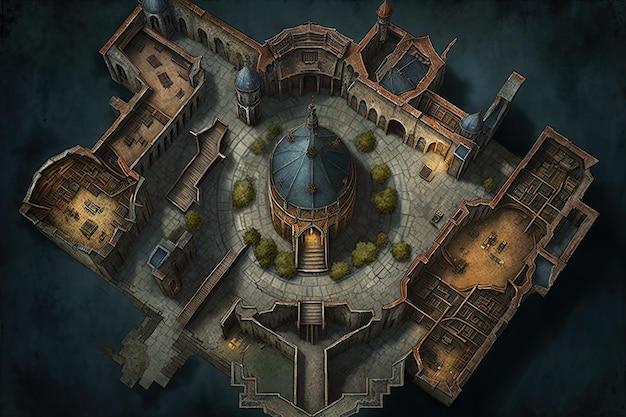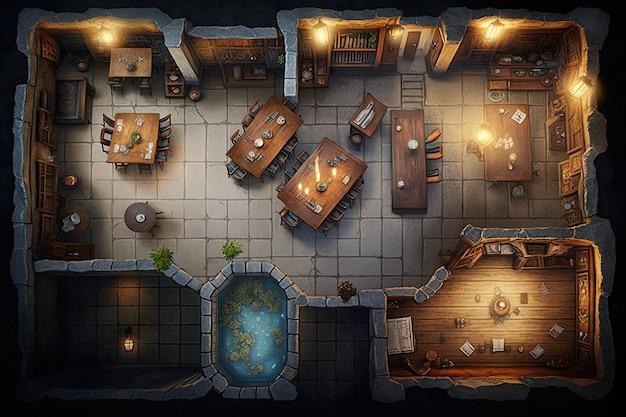When it comes to playing Dungeons and Dragons (DND), battle maps are an essential tool for bringing adventures to life. They provide visual representations of the game world, allowing players to strategize and immerse themselves in the action. But one question that often arises is, just how big should these battle maps be?
In this blog post, we will explore the factors to consider when determining the size of your DND battle map. We will dive into topics such as map scaling, dungeon size, and the preferences of renowned DMs like Matt Mercer. Whether you’re a seasoned DM or a newbie, this guide will help you create engaging battle maps that enhance your DND sessions. So grab your dice and get ready to discover the perfect size for your next epic adventure!
How to Create an Epic Battle Map in Dungeons & Dragons
Unleash the Power of Your Imagination with a Giant Battle Map
In the world of Dungeons & Dragons (D&D), there’s nothing more exhilarating than stepping into a battle scene filled with creatures, heroes, and a whole lot of dice rolling. As a Dungeon Master, creating an epic battle map is your ticket to transporting your players into a fantastical world where every decision matters.
The Size Really Does Matter, and We’re Talking Battle Maps!
When it comes to battle maps in D&D, size does matter – but not in the way you might think. While bigger may seem better, there’s a sweet spot that allows for both strategic gameplay and visual grandiosity. So, let’s dive into the factors that will help you determine the perfect size for your battle map.
A Canvas Fit for a Quest
First things first, you’ll need a suitable canvas for your battle map. Whether you prefer the old-school pen-and-paper approach or the tech-savvy digital realm, the choice is yours. Just make sure it fits your needs and allows you to unleash all your creative prowess. Now, let’s explore the different options available!
1. Pen and Paper: The Classic Choice
Ah, the nostalgic charm of drawing with a trusty pencil and graph paper. This traditional method gives you the freedom to envision the world on a blank canvas and bring it to life one stroke at a time. It’s perfect for those who enjoy the tactile experience of physical creation.
2. Digital Platforms: Where Fantasy Meets Technology
If you’re feeling tech-savvy, there’s an array of digital tools available to create stunning battle maps. From dedicated software like Dungeon Painter Studio to online platforms like Roll20, the digital realm offers endless possibilities. Plus, you can easily share your creations with players all over the land!
Size Matters: Striking the Perfect Balance
Now that you’ve chosen your canvas, it’s time to determine the size of your battle map. Bear in mind that a map that’s too small can make battles feel claustrophobic and limit tactical options, while a map that’s too large might turn a skirmish into a marathon. So, let’s find that sweet spot!
1. Consider the Party Size
When sizing up your battle map, consider the number of players in your party. If you’re running a small group of adventurers, a smaller map will create a more intimate combat experience. However, for larger parties, a bigger map allows for epic battles and dynamic encounters that will keep everyone on their toes.
2. Encounter Intensity
The size of your battle map should also reflect the intensity of the encounter. Is it a minor skirmish or an all-out clash of epic proportions? Adjust the size accordingly to strike the perfect balance between giving your players room to strategize and creating a sense of grandeur that’ll leave them in awe.
Let Your Creativity Reign Supreme
Now that you’ve learned the secrets to sizing up your battle map, it’s time to unleash your inner cartographer! Whether you opt for the classic pen-and-paper or venture into the digital realm, remember that the most important thing is to have fun and create an immersive experience for your players. So, grab your dice, roll for creativity, and let the battle begin!
FAQ: How Big Should a DND Battle Map Be
Welcome to our FAQ guide on battle maps in Dungeons and Dragons! Whether you’re a dungeon master or a player, creating an interesting and immersive battle map is crucial for an enjoyable gaming experience. In this FAQ-style subsection, we’ll answer some common questions that arise when it comes to the size and creation of DND battle maps. So let’s dive right in!
How do I create a map for a DND battle
Creating a map for a DND battle can be a fun and creative process. Here are a few simple steps to get you started:
-
Sketch out your ideas: Begin by sketching your battle map on paper or using a digital tool. Consider the terrain, obstacles, and key features you want to include.
-
Choose a scale: Determine the scale you’d like to work with. The most common scale for battle maps is 5 feet per square, which is the standard movement measurement in DND.
-
Add details: Once you have the basic layout, add details like trees, buildings, and other objects to make the map visually appealing and engaging.
-
Use colors and textures: Enhance your battle map by adding different colors and textures to represent various terrain types, such as grass, water, or mountains.
-
Label important areas: Don’t forget to label important areas on your map, such as doors, traps, or objective points, to help players navigate and strategize effectively.
How big should a DND battle map be
The size of your DND battle map largely depends on the available playing space and the number of players involved. However, a common recommendation is to aim for a map size of around 24×36 inches. This size provides enough room for tactical movement and engagement while still being manageable for most tabletop setups.
What size should my fantasy map be
If you’re creating a fantasy world map for your DND campaign, the size can vary greatly. A world map typically covers a larger area and showcases various regions and continents. In this case, a standard size of 36×48 inches or larger would be appropriate to ensure enough detail and visibility for all players.
How big is a hex on a DND map
Hexes are another popular alternative to squares for DND maps. A typical hex on a DND map has a measurement of around one inch across (flat-to-flat). This measurement allows for smooth movement and positioning, accommodating the 5-foot scale often used in gameplay.
How long should a dungeon be in DND
The length of a DND dungeon can vary greatly depending on the complexity and your intended gameplay session’s duration. A dungeon can range from a quick one-room encounter to an extensive multi-level maze spanning multiple sessions. As a general guideline, a well-paced dungeon crawl can take anywhere from one to three gaming sessions to complete.
How does Matt Mercer make his maps
Matt Mercer, the renowned Dungeon Master of Critical Role, has a talent for creating stunning and immersive battle maps. While his exact techniques might remain a secret, he has mentioned using a combination of digital tools, such as Photoshop or professional map-making software, to design his intricate and detailed maps.
Is Matt Mercer really rich
While Matt Mercer’s popularity and success as a Dungeon Master are undeniable, it’s worth noting that wealth is subjective and private information. Although his contributions to the DND community have brought him prosperity, it’s best to admire his passion for storytelling and immersive game experiences without making assumptions about his personal finances.
Creating a captivating battle map is an important aspect of any DND game. By following the steps outlined above and considering the recommended sizes, you’ll be well on your way to crafting exciting and visually appealing maps that enhance your gaming sessions. So gather your pencils, digital tools, and imagination, and get ready to bring your DND battles to life!

